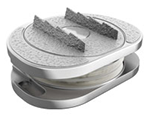The M6-C and M6-L artificial discs are designed as non-fusion alternatives to spinal fusion surgery for treating degenerative disc disease in the cervical and lumbar spine, respectively, offering a potential for preserving motion and mimicking the natural disc’s structure and function.
Here’s a more detailed breakdown:
M6-C (Cervical):
- What it is:The M6-C is an artificial cervical disc designed to mimic the structure and movement of a natural disc, offering a non-fusion solution for cervical disc degeneration.
- How it works:It features a shock-absorbing nucleus and a fiber annulus that work together to replicate the controlled range of movement and cushioning effect of a natural disc.
- Benefits:
- Mimics natural spine movement (up/down, side to side, forward/backward, rotation).
- Potentially minimizes stress on adjacent discs and vertebral structures.
- Can be a preferred option over spinal fusion (ACDF).
- Designed to replicate the motion characteristics of a natural disc, including compression and controlled range of motion.
- Indications:Intended for reconstruction of the disc following single-level discectomy in skeletally mature patients with intractable degenerative cervical radiculopathy.
- Components:
- Titanium endplates for anchoring to neighboring vertebrae.
- An artificial nucleus composed of an elastic material for cushioning and increased range of motion.
- An artificial outer ring composed of a movable fiber.
